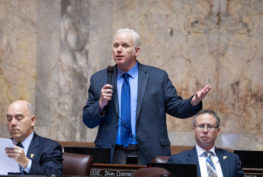Last night I voted against Senate Bill 5239, a bill that would eliminate the role of local governments in determining whether water is legally available before a building permit for a home is issued. This change to the state’s arcane water regulations would essentially make it possible for someone to install a well even if the well reduces the water available to others, redirects water to which someone else has prior rights, or illegally reduces stream flows critical to fish habitat.
Though the bill passed the Senate on a 28-21 vote, I do not expect it to pass the House in this form. This is an issue that needs to be solved, and it will be solved — but not by the approach in SB 5239, which would eliminate the key component of the landmark Hirst decision that helped resolve critical questions over water rights.
The battle over water rights is an old one, and it is contentious and complex. On one side are landowners who want to develop their property, and on the other is the reality that our natural resources are finite and that new wells can divert water from other users. At the core of it all is Washington’s longstanding “first in time, first in right” law that gives senior water users priority over new applicants.
Some background: How We Got to Hirst

In 1990, the Legislature passed the Growth Management Act (GMA) to prevent sprawl and to focus growth in urban areas while preserving agricultural and resource lands. Among other things, the GMA requires counties to incorporate plans and development regulations to protect ground and surface water supplies; it also amended Subdivision Code to require that, in order to receive a building permit, the applicant must identify an available water supply to serve the uses of the building.
In 2016, the state Supreme Court held in the Hirst decision that Whatcom County did not comply with these GMA requirements. The court said the county must require building permit applicants to demonstrate water is legally available, not just physically available. Since groundwater in much of the Nooksack basin is in hydraulic continuity with surface waters, new well withdrawals have the potential to disrupt minimum flow standards adopted by regulation in 1985. Under the Water Code, such minimum flow is treated like a water right: “first in time, first in right.”
In the Hirst case, Whatcom County and the state Ecology Department argued that the 1985 rule expressly excluded smaller-use wells (such as for homes) from prohibitions on new withdrawals. The court, however, rejected this argument and found the rule did not address these “exempt” wells and that the county could not rely on the rule in determining if a well might impair minimum flow standards.
That left the question of whether or not counties have the information and capacity to determine the legal availability of water. Hydraulic continuity has not been mapped or assessed, and is costly and time consuming to perform. SB 5239 would eliminate any oversight of new, small wells that could impact other users.
This is an important issue that the Legislature must address in this session to enable property owners to build in rural areas but in ways that do not deprive other water users of their water rights. When I worked with other legislators to develop a Dungeness Water Program in 2014, we created a mechanism to fully mitigate the impact of new water well withdrawals by using old water rights that are no longer being used. This is an example of the type of mitigation approaches that might be employed elsewhere in the state to allow new development.
Though I am confident we will resolve this issue in this legislative session, I have to admit I don’t think it will happen before we first resolve the need to adequately fund our public schools.
![]()




